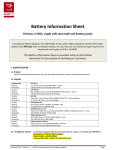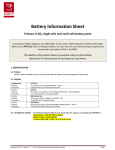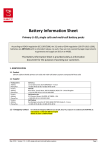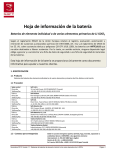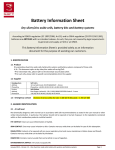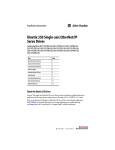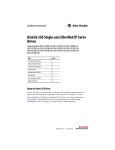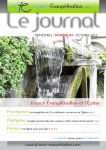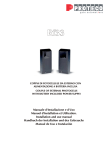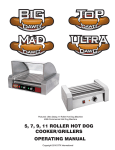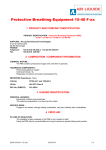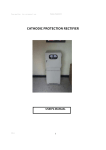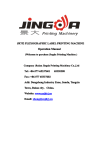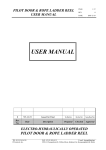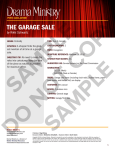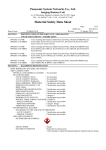Download SCHEDA DI SICUREZZA
Transcript
Safety Data Sheet for Primary Li-SOCl2 single cells and multi-cell battery packs According to REACH regulation (EC 1907/2006, Art 31) and to OSHA regulation (29 CFR 1910.1200), batteries are ARTICLES with no intended release. As such, they are not covered by legal requirements to generate and supply an SDS or an MSDS. This Battery Information Sheet is provided solely as information document for the purpose of assisting our customers. 1. IDENTIFICATION 1.1 Product Lithium-thionyl dichloride primary unit cells and multi-cell battery systems composed of these cells 1.2 Supplier Name : Vitzrocell, Co. Ltd Address : 256-41 Dugok-ri, Sinam-myon, Yesan-gun, ChungCheong Nam-Do Tel : +82-41-332-8642~5 Fax : +82-41-332-8646 Website : www.vitzrocell.com 1.3 Emergency contact chemical emergency ONLY (in case of spill, leak, fire, exposure or accident) call CHEMTREC at: International: +1-703-527-3887 for English North America: +1-800-424-9300 For more information : +82-2-2024-3220 2. HAZARD IDENTIFICATION The Li-SOCl2 batteries described in this Battery Information Sheet are sealed units which are not hazardous under normal operating conditions in accordance with manufacturer’s recommendations, as stated in the user’s manual or other similar documentation. Under normal use, the battery integrity is maintained and the active components it contains are isolated from the outside. In particular, the battery should not be submitted to any mechanical (opening, puncture, immersion), thermal (burning, heating to temperatures above the normal temperature range of the product) or electrical abuse (short-circuit, recharge, forced discharge), which will lead to the activation of safety valves and/or the rupture of the battery container. Any accidental release of the inner components of the cell, or their combustion products could be highly hazardous. Battery content exposition to air humidity/liquid water may be followed by severe battery vent/explosion/fire, depending on the hazard causes and circumstances. Protection from charging: Whenever lithium batteries are not the single power source in a circuit, the following measures recommended by Underwriters Laboratories are relevant. The cells should not be connected in series with an electrical power source that would increase the load through the cells. The electronic circuit shall include one of the following: A. Two suitable diodes or the equivalent in series with the cells to prevent any reverse (charging) current. The second diode is used to provide protection in the event that one would fail. Quality control, or equivalent procedures, shall be established by the device manufacturer to check that the diode polarity is correct for each unit. or B. A blocking diode or the equivalent to prevent any reverse (charging) current and a resistor to limit current in case of diode failure. The resistor should be sized to limit the reverse (charging) current to the maximum value according to the data sheet of the cell. - Page 1/5 – 3. COMPOSITION, INFORMATION OR INGREDIENTS Each unit cell consists of a hermetically sealed metallic can containing a number of chemicals and materials of construction of which the following are potentially hazardous upon release to air. Component CAS Number EINECS/ELINCS Content (wt. %)* Lithium metal 7439-93-2 231-102-5 2-6 Thionyl dichloride 7719-09-7 231-748-8 18-47 Aluminium chloride 7446-70-0 231-208-1 1-5 Gallium chloride 13450-90-3 236-610-0 0-2 Lithium chloride 7447-41-8 231-212-3 1-2 Carbon 1333-86-4 215-609-9 2-5 PTFE 9002-84-0 N/A 0-1 Stainless steel, Nickel N/A N/A remainder and inert material * Quantities may vary with cell model 4. HANDLING AND STORAGE IMPORTANT NOTICE: Lithium-thionyle chloride batteries are not rechargeable and should not be tentatively charged or recharged. Manufacturer’s recommendations should be followed regarding maximum current and operating temperature range. Applying pressure or deforming the battery may lead to disassembly and cause eye, skin and throat irritation. . STORAGE: Store in a cool, regulated (preferably below 21°C and in any case below 30°C), dry and ventilated area, away from possible sources of heat, open flames, food and drink. Avoid exposure to direct sunlight for long periods. Temperatures above 100° may cause leakage and rupture, and result in shortened battery service life. Keep proper clearance space between batteries and walls. Since short circuit can cause burn hazard, leakage or explosion hazard, keep batteries in original packaging until use and do not mix them. HANDLING: -) terminal with conductors. not mix batteries of different types or mix new and old ones together. use can cause leakage or spout vaporized electrolyte fumes and may cause fire or explosion. 5. PHYSICAL AND CHEMICAL PROPERTIES The lithium-thionyl chloride cell or battery described by this Battery Information Sheet is a sealed unit when offered for sale. It is a manufactured “article” and does not expose the user to hazardous chemicals when used in accordance with manufacturer specifications. Appearance – Cylindrical shape Odour – If leaking, gives off a pungent corrosive odour Flash point – Not applicable Flammability – Not applicable Boiling Point – Not applicable Melting Point – Not applicable Vapor Pressure – Not applicable Vapor Density – Not applicable pH – Not applicable Specific Gravity – Not applicable Solubility (in water) – Not applicable Solubility (other) – Not applicable 6. STABILITY AND REACTIVITY The battery system is stable when handled and stored according to section 4. MATERIALS TO AVOID: Oxidizing agents, bases, water. Avoid electrolyte contact with aluminium of zinc. CONDITIONS TO AVOID: Do not heat above 100°C (or higher (150°C) for High Temperatures cells and batteries such as - Page 2/5 – the LSH20-150 cell- refer to individual data sheets for maximum temperatures) or incinerate. Do not disassemble, crush, pierce, short, charge or recharge. Avoid mechanical or electrical abuse. HAZARDOUS DECOMPOSITION PRODUCTS: Hydrogen (H2) as well as lithium oxide (Li2O) and lithium hydroxide (LiOH) dust are produced in case of reaction of lithium metal with water (hydrolysis). Chlorine (Cl2), sulfur dioxide (SO2) and disulfur dioxide (S2Cl2) are produced in case of thermal decomposition of thionyl dichloride above 100°C. Hydrochloric acid (HCl) and sulfur dioxide (SO2) are produced in case of reaction of thionyl dichloride with water at room temperatureHydrochloric acid (HCl) fumes, lithium oxide (Li2O), lithium hydroxide (LiOH) and aluminium hydroxide (Al(OH) 3) dust are produced in case of reaction of lithium tetrachloroaluminate (LiAlCl 4) with water. 7. TOXICOLOGICAL INFORMATION There is no risk, unless the battery ruptures. In the event of accidental exposure to internal contents, corrosive fumes will cause severe skin, eye and mucous membrane irritation. Medical conditions are generally aggravated by exposure to battery internal contents: eczema, skin allergies, lung injuries, asthma and other respiratory disorders may occur. Overexposure may cause symptoms of non-fibrotic lung injury and ingestion can cause tissue damage to throat and gastro-respiratory tract. 8. ECOLOGICAL INFORMATION The batteries do not contain mercury, cadmium or other heavy metals. Eco-toxicity None known if used/disposed of correctly. Mammalian affects None known if used/disposed of correctly. Bioaccumulation potential None known if used/disposed of correctly. Environmental fate None known if used/disposed of correctly. 9. DISPOSAL CONSIDERATIONS Batteries do not contain hazardous materials according to EC Directives 91/157/EEC, 93/86/EEC, and 2002/95/EC (RoHS) Directive). Battery recycling is either mandatory or recommended: The European Directive 2006/66/EC has been implemented by most EC member states. Dispose of in accordance with local laws and regulations. Store material for disposal as indicated in Section 4. A disposal service is offered upon request by Tadiran Batteries. Do not incinerate, or subject cells to temperatures in excess of 100°C (or 150°C for LSH20-150 cells and the battery packs assembled from them). Such abuse can result in loss of seal, electrolyte leakage and/or violent disassembly with risk of material projections. 10. TRANSPORTATION INFORMATION Note: when manufacturing a new battery pack, one must assure that it has fulfilled the tests according to the UN Model Regulations, Manuel of Tests and Criteria, Part III, subsection 38.3. 10.1 United Nations Class For the single cell batteries and multi-cell battery packs that are non-restricted to transport (non-assigned to the Miscellaneous Class 9), use lithium batteries inside label. For the single cell batteries and multi-cell battery packs which are restricted to transport (assigned to Class 9), use Class 9 Miscellaneous Dangerous Goods and UN Identification Number Labels. In all cases, refer to the product transport certificate issued by the manufacturer. November 2012 – Version 1.1 – Li-SOCl2 single cells and multi-cell battery systems Page 5 - Page 3/5 – UN Numbers: 3090 LITHIUM METAL BATTERIES: Shipment of cells and batteries in bulk 3091 LITHIUM METAL BATTERIES CONTAINED IN EQUIPMENT or LITHIUM METAL BATTERIES PACKED WITH EQUIPMENT: Cells and batteries contained in equipment or packed with it Shipping name LITHIUM METAL BATTERIES Hazard Classification: 9 Depending on their lithium metal content, some single cells and small multi-cell battery packs may be non-assigned to Class 9. Refer to Transport Certificate. Packaging: Group II 10.2 International agreements By Air International: IATA/ICAO: UN 3090 or UN3091 By Sea International: IMDG: UN 3090 or UN 3091 European road transportation: ADR European rail transportation: RID 11. REGULATORY INFORMATION Regulations specifically applicable to the product: - ACGIH and OSHA: see exposure limits of the internal components of the battery in section 14. - IATA/ICAO (air transportation): UN 3090 or UN 3091. - IMDG (sea transportation) : UN 3090 or UN 3091. - Transportation within the US-DOT, 49 Code of Federal Regulations - UK regulatory references: Classified under CHIP. - Battery Directive (2006/66/EC): see section 9 12. FIRST AID MEASURES (not anticipated under normal use) 12.1. Electrolyte contact EYE CONTACT: Immediately flush with plenty of water for at least 15 minutes and get medical attention. SKIN CONTACT: Remove contaminated clothing and immediately flush with plenty of water for at least 15 minutes. In severe cases, get medical attention. INHALATION: Contents of an opened cell may cause respiratory tract and mucus membrane irritation. Remove from exposure, rest and keep warm. Immediately inhale Cortisone spray. In severe cases, track medical surveillance for 48 hours. INGESTION: Wash out mouth thoroughly with water and give plenty of water to drink. Get medical attention. FURTHER TREATMENT: All cases of eye contamination, persistent skin irritation and casualties who have swallowed this substance or have breathed its vapours should be seen by a Doctor. 12.2. Lithium metal contact EYE CONTACT: Immediately flush with large quantities of water for at least 15 minutes, with open eyelids, and get medical attention. SKIN CONTACT: Remove particles of lithium from skin as quick as possible. Immediately flush with plenty of water for at least 15 minutes and get medical attention. November 2012 – Version 1.1 – Li-SOCl2 single cells and multi-cell battery systems Page 6 INHALATION/INGESTION: Contents of an opened cell may cause respiratory tract and mucus membrane irritation. Remove from exposure, rest and keep warm. Immediately inhale Cortisone spray. In severe cases, track medical surveillance for 48 hours. 13. FIRE FIGHTING MEASURES (not anticipated under normal use) ESTINGUISHING MEDIA: -based foam has some cooling effect and is effective to prevent fire expansion as long as the extent of the fire has not progressed to the point that the lithium metal they contain is exposed (as marked by appearance of deep red flames). Do not use warm or hot water. -X Class D extinguishers are effective on fires involving only a few lithium batteries. 2 or Halon-type extinguishers. not use sand, dry powder or soda ash, graphite powder or fire blankets. Use only class D metal extinguishers on raw lithium metal. - Page 4/5 – SPECIAL FIRE FIGHTING PROCEDURES: -contained breathing apparatus. ass of extinguishing medium, specified above, on these batteries or their packing material. Cool exterior of batteries if exposed to fire to prevent rupture. ay be supplied using a diffuser type nozzle so that the cells remain cool during the fire containment and extinction. A sprinkler system should be suitable for this purpose, the critical factor being that the lithium cells do not experience temperatures above the melting point of lithium (180°C). Standard dry powder extinguishers are ineffective. It should be kept in mind that a hazard of hydrogen formation exists whenever hot lithium metal comes into contact with water. 14. EXPOSURE CONTROLS AND PERSONAL PROTECTION* (not anticipated under normal use) Respiratory protection In all fire situations, use self-contained breathing apparatus Hand protection In case of leakage wear protective gloves Eye protection Safety glasses are mandatory during handling Other In the event of leakage or ruptured cells, wear a rubber apron and protective clothes 15. ACCIDENTAL RELEASE MEASURES (not anticipated under normal use) INDIVIDUAL PRECAUTIONS: Evacuate the employees from area until fumes dissipate. In case of electrolyte leakage from a cell or battery, do not inhale vapors or touch liquid with bare hands. In case of skin or eye contact, inhalation or ingestion, follow the measured described in section 12. ENVIRONMENTAL PRECAUTION: Avoid sewage, surface water and underground water contamination. Avoid ground and atmosphere contamination. WAYS OF CLEANING: With protective glasses and gloves, use absorbent material (sand, earth, chalk (CaCO3) or lime (CaO) powder or Vermiculite) to absorb any exuded material. Seal leaking battery (unless hot) and contaminated absorbent material tight in plastic bag, and dispose of as hazardous waste in accordance with local regulations. Electrolyte traces may be wiped off dryly using household paper. Rinse with water afterwards. 16. OTHER INFORMATION This information has been compiled from sources considered to be dependable and is, to the best of our knowledge and belief, accurate and reliable as of the date compiled. However, neither exhaustively nor perfect reliability can be granted. Information does not imply implicit or specific warranty of it. This information relates to the specific products designated and may not be valid for such products used in combination with any other materials or in any process. It is the user’s responsibility to satisfy himself as to the suitability and completeness of this information for his particular use. Saft does not accept liability for any loss or damage that may occur, whether direct, indirect, incidental or consequential, from the use of this battery information sheet provided as a service to our customers. Saft does not offer warranty against patent infringement. - Page 5/5 –





